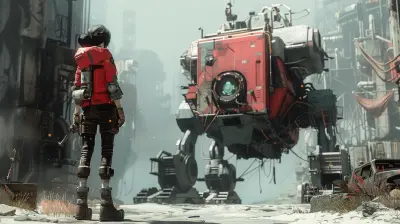Learning Curves vs Leveling Curves in Game Design
23 October 2025
So you’ve just booted up a flashy new game. Within five minutes, you’ve tripped over your own inventory system, picked the wrong class (obviously), and accidentally launched a fireball at your party healer. Classic. But hey—it’s not your fault. That’s just the learning curve slapping you in the face like a goblin with something to prove.
Meanwhile, five hours in, you're grinding rats in a sewer wondering why you’re still level 3 when your buddy is out there slaying dragons and hoarding loot. Enter: the leveling curve. Two very different beasts. One teaches you how not to suck. The other determines how long you’ll suck.
In this article, let’s dive into the glorious (and sometimes cruel) world of learning curves vs leveling curves in game design. Grab your virtual sword, buckle up your imaginary boots—things are about to get nerdy, funny, and surprisingly insightful.
What the Heck is a Learning Curve?
Let’s break it down. The term “learning curve” sounds academic—like something you’d hear in an awkward corporate training seminar. In gaming though? It’s basically how fast (or how painfully) players pick up the game’s mechanics, systems, and maybe even the lore (if you’re feeling spicy).Picture This
Imagine a game drops you in with zero explanation. Suddenly, you’re holding a rusted spoon and facing an undead hydra. That's a steep learning curve. You’re clueless. You mash buttons. You die. Repeatedly. Now contrast that with a nice, smooth curve: the game gradually adds mechanics, gives you time to breathe, and doesn't punish you for not knowing the ancient combo system passed down through generations of elite players.A good learning curve teaches you how to play without needing a 17-tab Wiki open. A bad one? It's like being thrown into a calculus exam when you just learned to count apples.
What’s a Leveling Curve Then?
Same rollercoaster theme, different ride. The leveling curve relates to how your character gains experience or levels throughout the game. Fast early gains, painful late-game slogs? Yep, that’s by design.Grinding 101
You ever spend six hours smacking boars just to crawl from level 19 to 20? That’s a steep leveling curve toward the end. Some games set it up this way to stretch content, others to gatekeep higher abilities and make progression feel “earned.”But sometimes, it just feels like the game’s trying to see how long you’ll tolerate hunting wolves before losing your will to play.
Learning vs Leveling Curve: The Smackdown
All right, let’s do a side-by-side showdown. Because people confuse these two more than they confuse their potion hotkey with “self-destruct.”| Feature | Learning Curve | Leveling Curve |
|--------|----------------|----------------|
| Focus | Player skill and understanding | Character progression and experience |
| Starts When? | Immediately (usually within seconds) | After first XP gain or level-up |
| Punishment Style | "Oops, you died because you didn't know X mechanic" | "Grind until your eyes bleed" |
| Examples | Combat systems, crafting, menus, controls | XP scaling, level gaps, loot drops |
| Fixed or Dynamic? | Often improves as the player learns | Designed and manipulated by devs for pacing |
Still with me? Great. Your XP bar on game knowledge just dinged.
Why Game Designers Should Care (A Lot)
Here’s the thing. Game designers have to juggle both these curves like flaming torches at a Renaissance Fair. If you mess up one, your players are confused. Mess up both? They uninstall, leave a scathing Steam review, and flee back to less traumatic games… like Minesweeper.The Learning Curve Trap
Throwing players into deep water without floaties is a design sin. (Looking at you, hyper-realistic survival sims.) A gentle learning process is key. Think of how Portal slowly teaches you mechanics—without a single wall of text. Now that’s chef’s kiss design.The Leveling Curve Pitfall
Make the grind too easy? Players zoom through content and get bored. Too hard? They give up at level 12, right after their third coffee-fueled ragequit session. The key here is pacing—keeping progress satisfying without handing out gold-plated dragon armor for killing two rats.When Learning and Leveling Get Tangled
Oh, the infamous combo. Let’s say your game has an intricate combat system (learning curve), but you also need to level up to unlock moves that make it fun (leveling curve). If players never reach the “fun” because the leveling is too slow—and they can’t learn the cool stuff? You’ve double-whammied them into quitting.Or the reverse: your leveling curve is lightning-fast, but your learning curve is a nightmare. Players level up before truly understanding the core mechanics. Now they’re high-level, still playing like a confused squirrel in armor. Not ideal.
Examples: Games That Got It Right (and Wrong)
Let’s name-drop, shall we?✅ The Good Stuff
- Dark Souls: Yes, the learning curve punches you in the ribs, but it’s consistent. Once you “get it,” you’re golden. The leveling is slower but rewarding.- Pokémon (classic versions): Smooth learning for kids and adults alike. Leveling starts brisk and slows just enough to encourage exploration and variety.
- Hades: Super tight loop. Easy to pick up, hard to master. Learning curve is gorgeous—every death actually teaches something. Leveling curve gives just enough carrot on the stick.
❌ The “Needs Some Milk”
- MMORPGs Gone Wild: Some titles (cough early WoW clones) had brutally steep leveling curves post-level 30. No man's land of experience. Meanwhile, learning curve was too easy early on—players hit a wall later with no toolkit.- Survival Sims: Many drop you into a freezing forest with nothing but a hunger meter and cryptic inventory system. Learning curve? Everest. Leveling? What leveling?
How to Balance the Two (Without Causing Brain Meltdowns)
Okay aspiring devs, here’s your survival kit:1. Tutorials That Don’t Suck
Skip the generic “press W to move” if your game's more complex. Instead, build mechanics into the moment. Let players do, rather than read. Think little puzzle-box tutorials inside the main game.2. Reward Learning with Leveling (and Vice Versa)
Want players to master a combo system? Make that mastery accelerate leveling. Or, unlock cool new mechanics through the leveling path. The two systems should be best buds.3. Use Metrics and Feedback
Watch playtests like a hawk. Where do players stumble? When do they stop gaining levels? Where does engagement nosedive? Adjust those curves accordingly.4. Give Players Control
Imagine if players could affect XP gain through skillful play. Games like Risk of Rain or Slay the Spire reward smart decisions and progress. Letting players speed up or slow down based on performance makes both curves feel fair.Curves Are for Personality, Not Pain
Look, we’re not saying games should be easy. Far from it. That satisfying “aha!” moment from mastering a mechanic? That's game dopamine. Or the thrill of finally hitting level 50 and unlocking your flaming sword of awesomeness? Straight serotonin.But if you make the climb a mix of Everest and molasses, players bail. Everyone loves a good challenge—but nobody wants to feel like the challenge is understanding how to interact with your game, or waiting 20 hours to have fun.
Final Thoughts: Treat Your Curves with Care
Balancing learning curves and leveling curves isn’t just a design technicality—it’s the heart of whether your game sticks. Nail one and fail the other? You risk becoming “that game I tried once” in someone’s backlog. Nail both? You’re on your way to becoming a classic.So whether you’re a developer, a player, or just someone who dies repeatedly in tutorial zones, remember this: every curve can either be a handshake—or a slap.
Choose wisely.
all images in this post were generated using AI tools
Category:
Leveling UpAuthor:

Lucy Ross
Discussion
rate this article
1 comments
Josephine McNaughton
Learning curves are like the awkward first date of gaming—confusing, a bit uncomfortable, but necessary for growth. Leveling curves? That’s just the cheat code to impress your friends. Just remember: both can lead to a great adventure, or an epic faceplant!
October 31, 2025 at 4:49 AM

Lucy Ross
Great analogy! Both learning and leveling curves shape the gaming experience, balancing challenge and growth. Thanks for sharing your thoughts!


